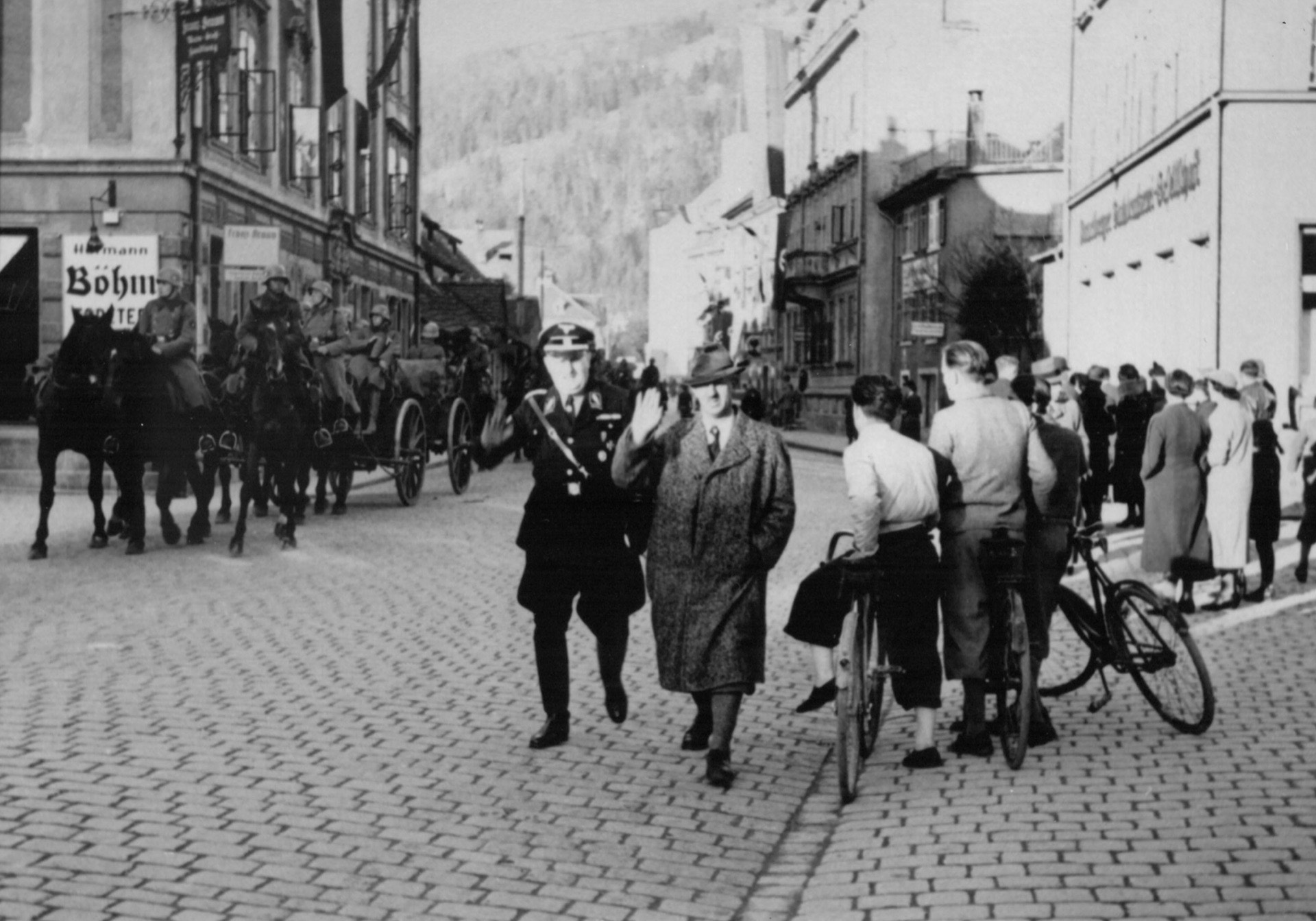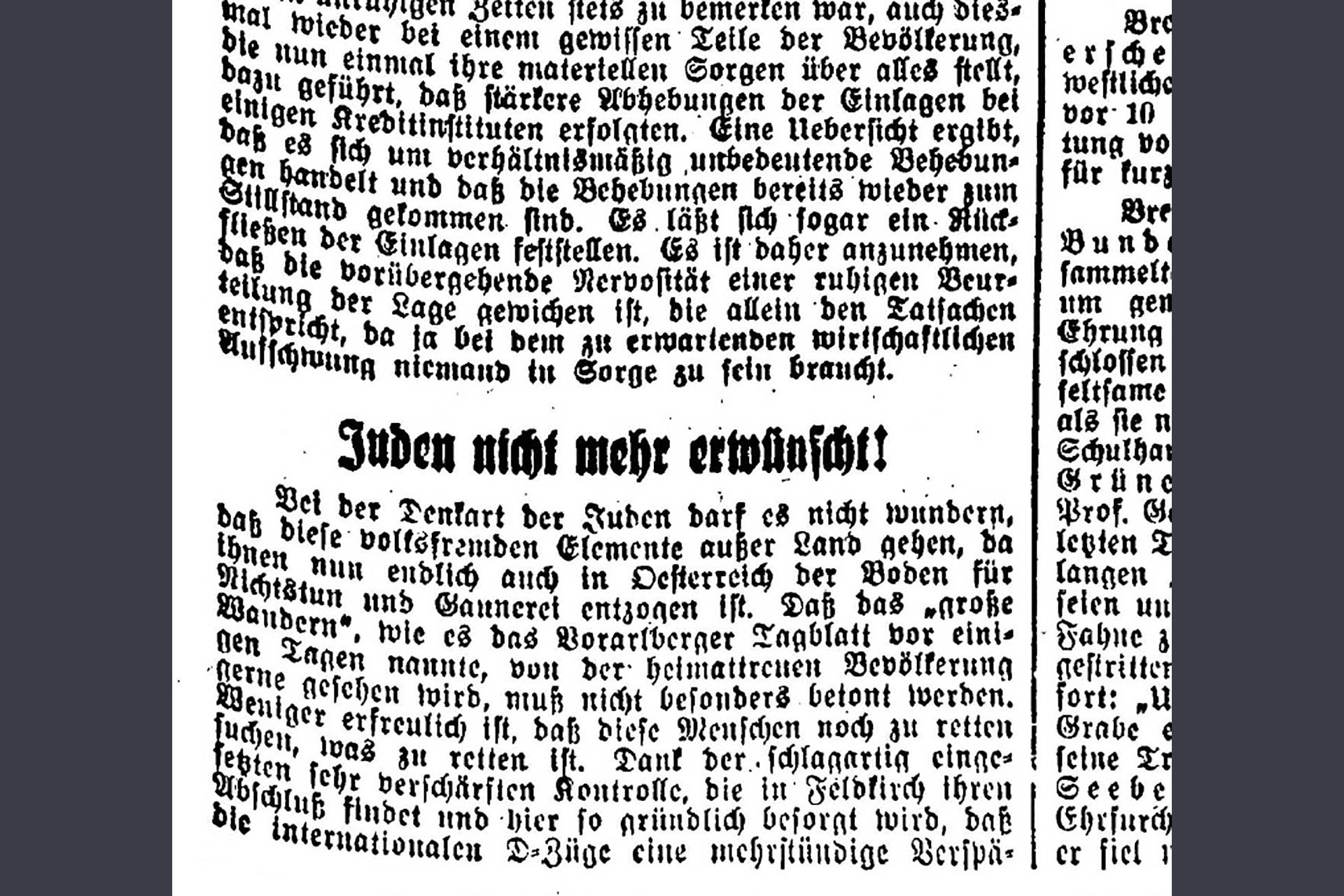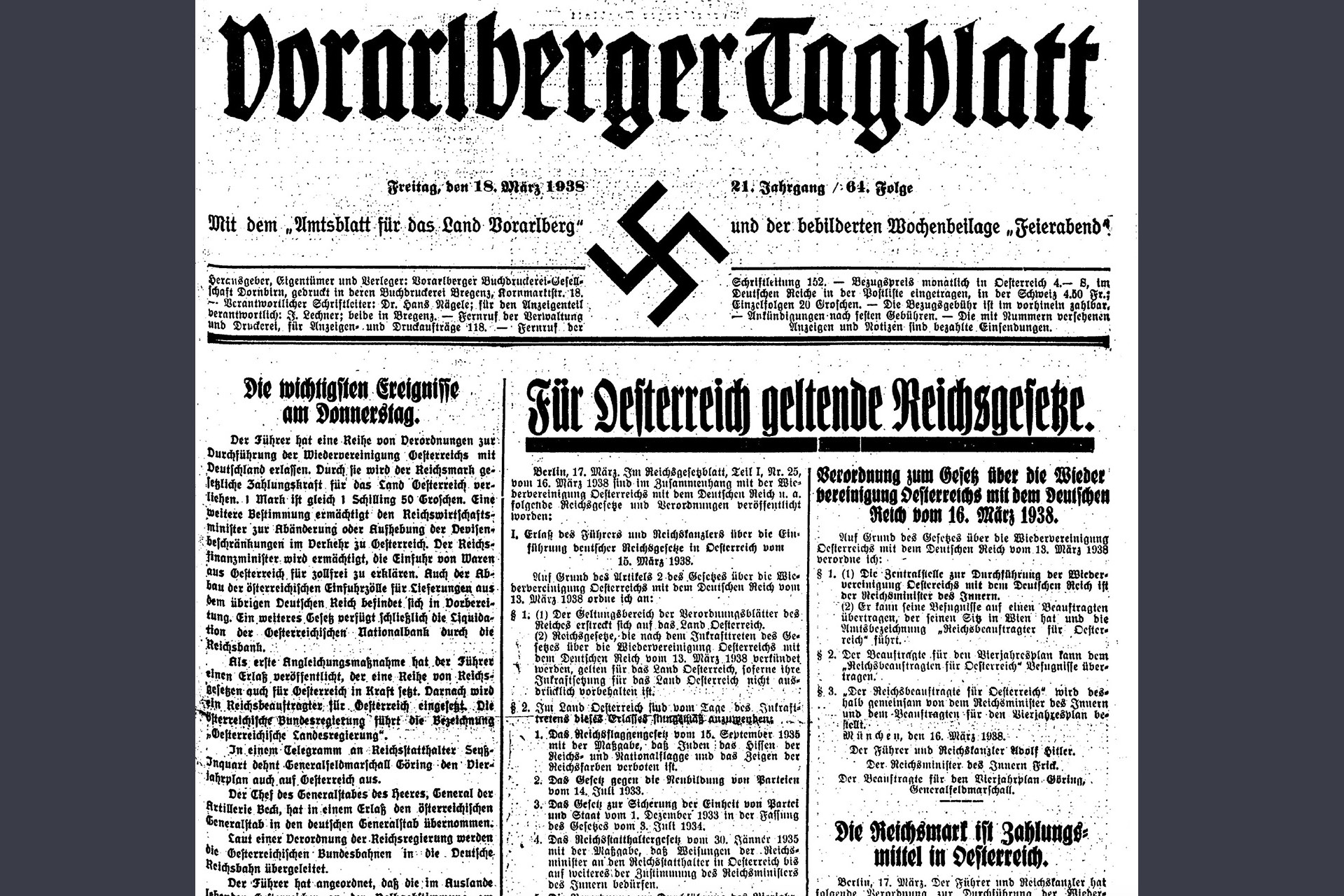Vorarlberger Tagblatt> March 18, 1938
3 Vorarlberger Tagblatt
The Vorarlberger Tagblatt mocks Jewish refugees
Bregenz, March 18, 1938
With the annexation of Austria to Nazi Germany, the hunt for political opponents and the Jewish population is beginning in Vienna. The resulting mass exodus from Vienna also arouses the scorn of the “großdeutsche” Vorarlberger Tagblatt. Its editorial office is located in Bregenz at Kornmarktstraße 18. Soon the Tagblatt is the National Socialist monopoly newspaper in the state. Every day it mocks the Jewish refugees – and warns of the damage to the Austrian economy caused by the “misappropriation of assets”. The systematic robbery of the refugees becomes the priority task of the border officials, who are already supported on March 11 by volunteers, for example, from the anti-Semitic Feldkirch Touring Club.
On March 18, in the Vorarlberger Tagblatt, under the headline “Jews no longer wanted!”, one can read:
“Given the way the Jews think, it should not be surprising that these elements alien to the people leave the country since in Austria the grounds for idleness and crookedness have been withdrawn from them. It need not be particularly emphasized that the ‘great wandering’, as the Vorarlberger Tagblatt termed it a few days ago, is welcomed by the people who are loyal to their homeland. What is less pleasing is that these people are still trying to save what can be saved. Thanks to the recently introduced but very tightened controls, which are enforced in Feldkirch and are so thoroughly applied, that the international D-trains experience a delay of several hours, it has already been possible in the first few days to secure considerable capital assets and to preserve them for the German people. The control carried out at the Feldkirch railway station led to the confiscation of money and financial assets totaling 121,353 S(chilling) in the period up to noon on March 16. The travelers who wanted to carry off these assets are sufficiently identified by the mention of a few names: Charlotte Riesenfeld, Gustav Seemann, Balla Hirschberg, Friedrich Pollak, Moritz Brotfeld, Dr. Morgenstern, Georg Jakobsohn, Isaak and Sara Wachs, Emilie Rosenbaum, Julie Zweig, Dr. Lindenbaum, Dr. Kunststadt, Melanie Lindenbaum, Ludwig Zweig, Ludwig Schwarzschild, Alexander Goldstein, Edit Löwenstamm, Zima Löw etc. This small selection of names is sufficient to establish the racial affiliation! We only wish that these people never return!”[1]
[1] Vorarlberger Tagblatt 18.3.1938, p. 5.
3 Vorarlberger Tagblatt
The Vorarlberger Tagblatt mocks Jewish refugees
Bregenz, March 18, 1938
With the annexation of Austria to Nazi Germany, the hunt for political opponents and the Jewish population is beginning in Vienna. The resulting mass exodus from Vienna also arouses the scorn of the “großdeutsche” Vorarlberger Tagblatt. Its editorial office is located in Bregenz at Kornmarktstraße 18. Soon the Tagblatt is the National Socialist monopoly newspaper in the state. Every day it mocks the Jewish refugees – and warns of the damage to the Austrian economy caused by the “misappropriation of assets”. The systematic robbery of the refugees becomes the priority task of the border officials, who are already supported on March 11 by volunteers, for example, from the anti-Semitic Feldkirch Touring Club.
On March 18, in the Vorarlberger Tagblatt, under the headline “Jews no longer wanted!”, one can read:
“Given the way the Jews think, it should not be surprising that these elements alien to the people leave the country since in Austria the grounds for idleness and crookedness have been withdrawn from them. It need not be particularly emphasized that the ‘great wandering’, as the Vorarlberger Tagblatt termed it a few days ago, is welcomed by the people who are loyal to their homeland. What is less pleasing is that these people are still trying to save what can be saved. Thanks to the recently introduced but very tightened controls, which are enforced in Feldkirch and are so thoroughly applied, that the international D-trains experience a delay of several hours, it has already been possible in the first few days to secure considerable capital assets and to preserve them for the German people. The control carried out at the Feldkirch railway station led to the confiscation of money and financial assets totaling 121,353 S(chilling) in the period up to noon on March 16. The travelers who wanted to carry off these assets are sufficiently identified by the mention of a few names: Charlotte Riesenfeld, Gustav Seemann, Balla Hirschberg, Friedrich Pollak, Moritz Brotfeld, Dr. Morgenstern, Georg Jakobsohn, Isaak and Sara Wachs, Emilie Rosenbaum, Julie Zweig, Dr. Lindenbaum, Dr. Kunststadt, Melanie Lindenbaum, Ludwig Zweig, Ludwig Schwarzschild, Alexander Goldstein, Edit Löwenstamm, Zima Löw etc. This small selection of names is sufficient to establish the racial affiliation! We only wish that these people never return!”[1]
[1] Vorarlberger Tagblatt 18.3.1938, p. 5.




